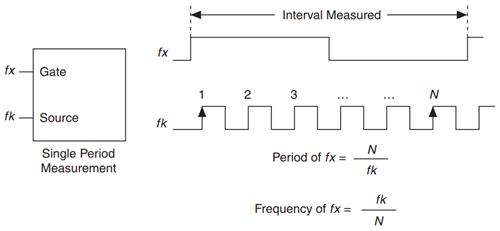Solution
For low frequency measurements with one counter, you measure one period of your signal using a known timebase (usually the on-board clock). The maximum frequency you can measure, as well as its accuracy, will depend in the card that you have. Follow the next steps to understand how to get this information:

Image: Low Frequency measurement with One Counter. Source: X Series User Manual .
- Look for the Device Specifications document for your device. You can find this information in the product's website, under the Manuals icon located at the bottom.
- Search for the Counters section (sometimes called "General-Purpose Counters"), where you will find the next information:
- Internal base clocks: The internal base clock for a counter is the signal that will cause the counter's value to increment/decrement depending on the state of the gate terminal.
- External base clock frequency: If a specific base clock rate is needed, most NI devices allow for the use of an external base clock. This clock serves all the same purposes as an internal base clock, but is externally provided by the user. The maximum rate of an external base clock is dependent on the bus of the device due to bandwidth limitations.
- Base clock accuracy: The accuracy of an internal base clock directly impacts the accuracy of any measurement or frequency generation from a general-purpose counter. This accuracy is also inherited from the overall device timebase accuracy, meaning that the accuracy of this clock can be improved if a higher accuracy master timebase is externally provided.
Note: Find more information about the meaning of these specifications here: Specifications Explained: NI Multifunction I/O (MIO) DAQ
- Using the information from the previous step, you can know the maximum frequency using the Nyquist Theorem, which tells us that if a continuous bandwidth-limited signal contains no frequency components higher than half the frequency at which it is sampled, then the original signal can be recovered without distortion. Therefore, your maximum frequency will be half of the base clock frequency you are using. For example, if your base clock runs at 100 MHz, your maximum frequency will be 50 MHz.
- For the accuracy of the measurement, it will depend on the hardware's specifications:
- If you are using the device's base clock: refer to the Base clock accuracy (ppm) specification in your device specifications document.
- If you are using an external base clock: refer to your external clock's documentation to find the accuracy of the generated signal.